You’ll need waterproof devices rated at least 5 ATM for sustained submersion pressures during long swims. Check that your gear handles saltwater’s corrosive effects, as standard ratings only account for freshwater. Test seals before each swim since cold water stiffens rubber barriers while heat accelerates aging. Remember that dynamic pressures from swimming strokes exceed static ratings, and temperature fluctuations create microcracks in seals. Professional maintenance guarantees long-term reliability for your most demanding aquatic adventures.
Understanding Water Depth Limitations for Waterproof Devices
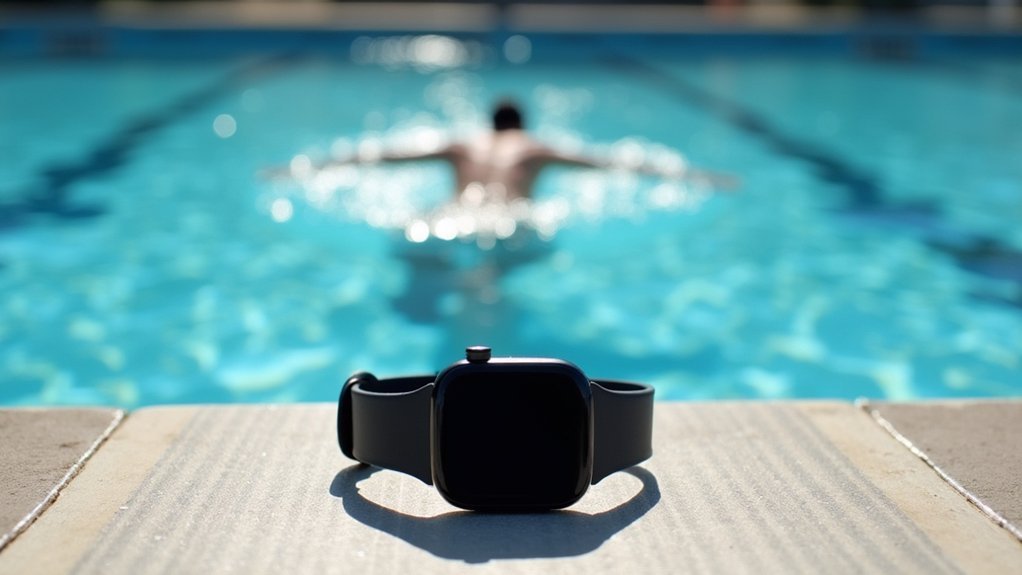
When you’re selecting waterproof devices for swimming, understanding the specific depth ratings isn’t just about numbers—it’s about ensuring your gear survives real-world conditions.
IP67 devices only handle 1-meter depths for 30 minutes, making them unsuitable for serious swimming. IP68 ratings vary considerably—some protect to 2 meters while others reach 6 meters for the same duration.
Water pressure increases dramatically with depth, adding 1 ATM every 10 meters. Your device’s seals face constant stress from dynamic pressure changes during swimming movements.
Even slight depth increases beyond ratings can compromise waterproof integrity over time. For long-distance swimming, you’ll need minimum 5 ATM ratings to handle sustained submersion pressures that exceed static test conditions. The first digit of the IP rating indicates protection against solid particles like sand and debris that swimmers encounter in open water.
Temperature Impact on Waterproof Seal Performance
While depth ratings grab most attention in waterproof device selection, temperature changes pose an equally serious threat to your gear’s seal integrity. Cold water stiffens rubber seals, reducing their flexibility and ability to maintain watertight barriers. Heat accelerates chemical breakdown in elastomers, causing permanent deformation and gradual performance loss.
| Temperature Extreme | Seal Impact |
|---|---|
| Cold ocean water (-2°C) | Seals become rigid, lose conforming ability |
| Tropical waters (35°C) | Accelerated aging, weakened polymer chains |
| Thermal cycling | Microcracks from expansion/contraction |
| Prolonged heat exposure | Compression set, permanent deformation |
| Below design limits | Increased leak risk, seal failure |
You’ll need devices with seals designed for your swimming environment’s temperature range to guarantee reliable waterproof protection. Proper material selection is crucial for maintaining optimal seal performance across varying water temperatures you’ll encounter during long-distance swims.
Saltwater Vs Freshwater Effects on Device Ratings
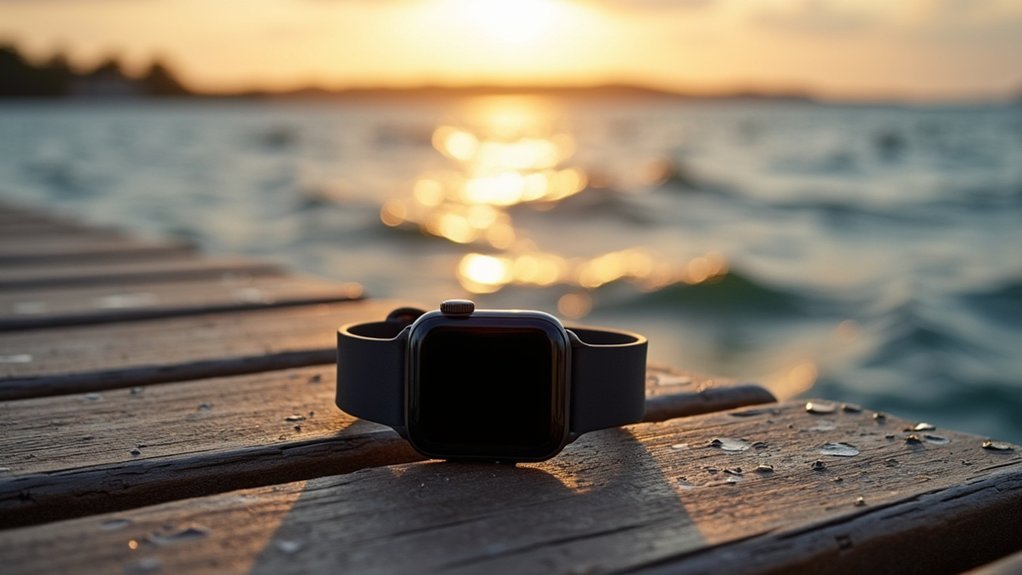
Temperature fluctuations aren’t the only environmental factor that affects your device’s waterproof performance.
Saltwater creates unique challenges that standard freshwater ratings don’t fully address. While your device might boast a 10 ATM or IPX8 rating, these specifications are tested in freshwater conditions that don’t account for saltwater’s corrosive properties.
The harsh reality of saltwater swimming includes:
Saltwater’s corrosive nature poses serious threats to waterproof devices that standard freshwater ratings simply cannot predict or prevent.
- Accelerated corrosion that can compromise your device’s seals and metal components
- Higher salinity levels that aren’t factored into standard IP or ATM testing protocols
- Increased maintenance demands to prevent permanent damage to your expensive equipment
You’ll need devices with stainless steel or titanium construction for saltwater durability. Remember that dynamic pressure from your swimming movements can reduce your device’s actual water resistance beyond its static laboratory rating.
Always rinse your equipment with freshwater immediately after ocean swims and inspect seals regularly for maximum protection.
Movement and Pressure Changes During Extended Swims
Beyond static water conditions, your swimming movements create dynamic pressures that can push waterproof devices well past their rated limits. Every stroke generates fluctuating external pressures that challenge seals, while dips and turns create momentary pressure spikes your device wasn’t designed to handle in laboratory testing.
Your swimming style directly impacts stress levels—freestyle’s repetitive motions differ from breaststroke’s pressure patterns.
Device positioning matters considerably. Loose gear bounces and rotates, increasing abrasion risks, while overly tight straps concentrate pressure and distort gaskets.
During endurance swims lasting hours, material fatigue compounds these stresses. Waves, currents, and turbulence add unpredictable forces that exceed static waterproof ratings. Cold water exposure between 16-31°C can also affect device performance and seal integrity over extended periods.
Real-world swimming conditions consistently surpass controlled laboratory environments where manufacturers test waterproof specifications.
Pre-Swim Waterproof Testing and Verification Methods
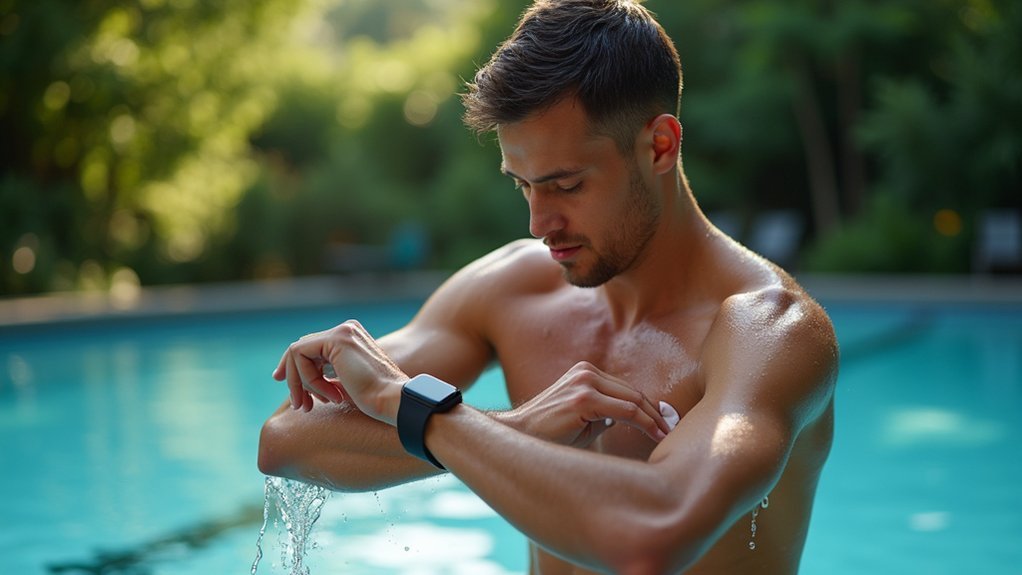
Before you enter the water, you’ll want to verify your waterproof equipment actually works as advertised.
Test your device’s basic functions while it’s dry, then examine all seals, gaskets, and closures for visible damage or debris that could compromise waterproof integrity.
A quick pre-swim inspection can save you from discovering a flooded device halfway through your training session. Store your waterproof testing equipment in a cool, dry place away from direct sunlight to maintain its effectiveness and reliability over time.
Equipment Function Testing
Conducting thorough pre-swim equipment testing guarantees your waterproof gear won’t fail when you need it most.
You’ll want to perform extensive functional checks that verify every feature operates correctly in wet conditions. Test your device’s buttons, touchscreen responsiveness, and display clarity while submerged or after water exposure.
Essential pre-swim function tests include:
- Emergency features verification – Test that your distress signals and emergency contacts work flawlessly when your life depends on them
- Navigation accuracy under pressure – Confirm GPS and compass functions maintain precision when you’re miles from shore in challenging conditions
- Battery performance validation – Verify your device won’t die mid-swim, leaving you stranded without communication or navigation capabilities
Remember that consistent testing practices ensure your equipment maintains accuracy throughout your swim, just as pool professionals rely on regular monitoring for safety compliance.
Don’t skip these critical checks. Your safety depends on equipment that functions perfectly when conditions get tough.
Seal Integrity Checks
Five critical seal integrity checks will determine whether your waterproof equipment can withstand the demanding conditions of open water swimming.
First, visually examine all gaskets and O-rings for cracks, cuts, or missing sections. Check mating surfaces for warping and verify no debris lodges in sealing channels. Look for discoloration indicating seal degradation.
Second, perform water immersion testing by submerging your device in clear water for the manufacturer-specified duration. Don’t press buttons during testing, then immediately check for interior water ingress. Understanding IP ratings helps swimmers choose equipment with appropriate protection levels for their specific water exposure conditions.
Third, use pressure testing with compressed air to identify leak paths at seal interfaces.
Fourth, apply silicone-based lubricant to O-rings, avoiding petroleum products that degrade seals.
Finally, document all test results and maintain compliance records for accountability.
Maintaining Seal Integrity Throughout Marathon Swimming Events
While marathon swimming pushes your body to its limits, seal integrity determines whether your wetsuit or drysuit will protect you throughout the entire event.
You’ll face constant challenges from saltwater exposure, temperature fluctuations, and repetitive swimming motions that can compromise your seals.
Your survival depends on proactive maintenance:
- Pre-swim rituals save lives – inspect every seal for cracks, clean thoroughly, and apply conditioners before entering the water
- Environmental awareness protects your gear – saltwater accelerates wear while cold conditions make seals brittle and prone to failure
- Emergency preparedness prevents catastrophe – carry neoprene glue for quick repairs and stage backup gear at checkpoints
Monitor your suit’s performance continuously.
Fatigue makes you careless with seal positioning, while prolonged water exposure causes edges to peel or fold, requiring immediate attention. Apply channel grease regularly to maintain seal flexibility and prevent chafing during extended swimming sessions.
Post-Swim Care to Preserve Waterproof Capabilities
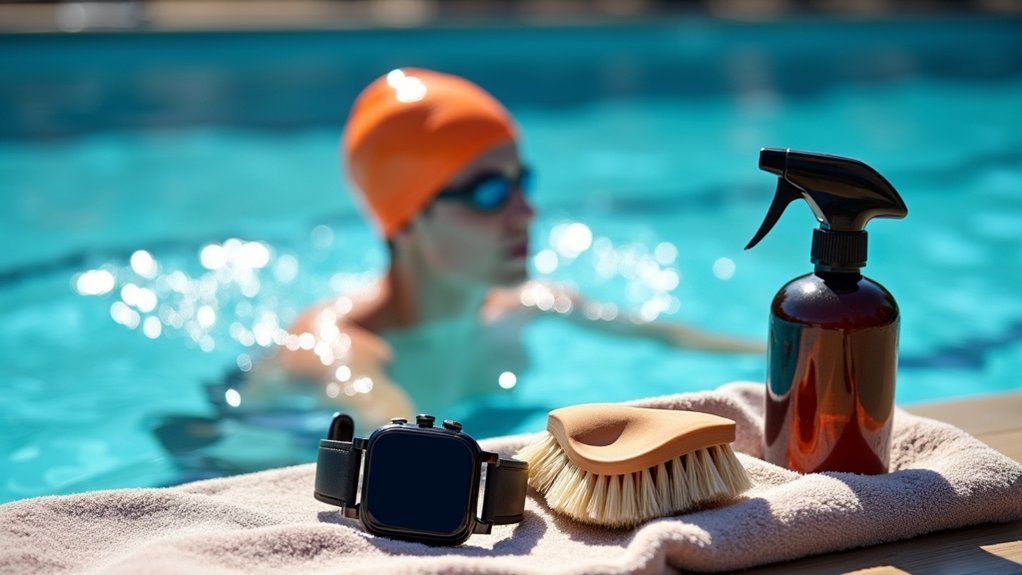
After completing your swimming session, immediate post-swim care determines whether your waterproof gear maintains its protective capabilities for future use.
Rinse your watch thoroughly with fresh water to remove chlorine and salt residue that causes corrosion. Avoid hot showers or saunas, as high temperatures expand gaskets and create entry points for moisture.
Use a soft cloth to clean your watch face and band, avoiding harsh chemicals that damage materials. Allow your watch to air dry completely before storage.
Check that your crown’s fully screwed down and inspect for visible damage or wear signs.
Store your watch in a dry environment away from extreme temperatures. Don’t overcrowd storage areas to prevent scratching.
Schedule professional pressure testing every few years to guarantee continued water resistance. Regular maintenance helps preserve the durability that swimmers rated at 4.5 stars across different sports watch brands.
Frequently Asked Questions
What Waterproof Rating Is Needed for GPS Devices During 10km+ Swims?
You’ll need at least a 5ATM rating for 10km+ swims, but 10ATM’s better for durability during long exposure. Don’t forget that GPS signals weaken underwater, so you’ll need surface breaks.
Do Waterproof Ratings Differ Between Pool and Open Water Swimming Conditions?
You’ll need higher waterproof ratings for open water swimming. Pool conditions are controlled and gentle, while open water presents currents, debris, temperature fluctuations, and dynamic forces that stress equipment more severely.
How Often Should Waterproof Seals Be Replaced on Timing Equipment?
You should replace waterproof seals on timing equipment every 1-2 years, but inspect them regularly for cracks, hardening, or damage that’d require immediate replacement regardless of age.
Can Extreme Cold Water Temperatures Cause Waterproof Device Failures?
Yes, extreme cold causes rubber seals to contract, compromising waterproof integrity. You’ll face increased failure risks from sudden temperature changes, seal brittleness, material fatigue, and potential condensation damaging internal electronics.
Which Waterproof Accessories Are Mandatory for Solo Marathon Swim Attempts?
You’ll need bright colored swim caps for visibility and identification as mandatory accessories. Depending on regulations, you might require waterproof communication devices or GPS trackers for safety monitoring during your attempt.
In Summary
You’ll protect your waterproof devices during long-distance swims by understanding depth limits, temperature effects, and saltwater impact. Don’t forget to test seals beforehand and monitor pressure changes while swimming. You’re investing in marathon-level endurance, so maintain seal integrity throughout your event and follow proper post-swim care routines. These seven tips guarantee your devices stay functional when you’re pushing your limits in open water.

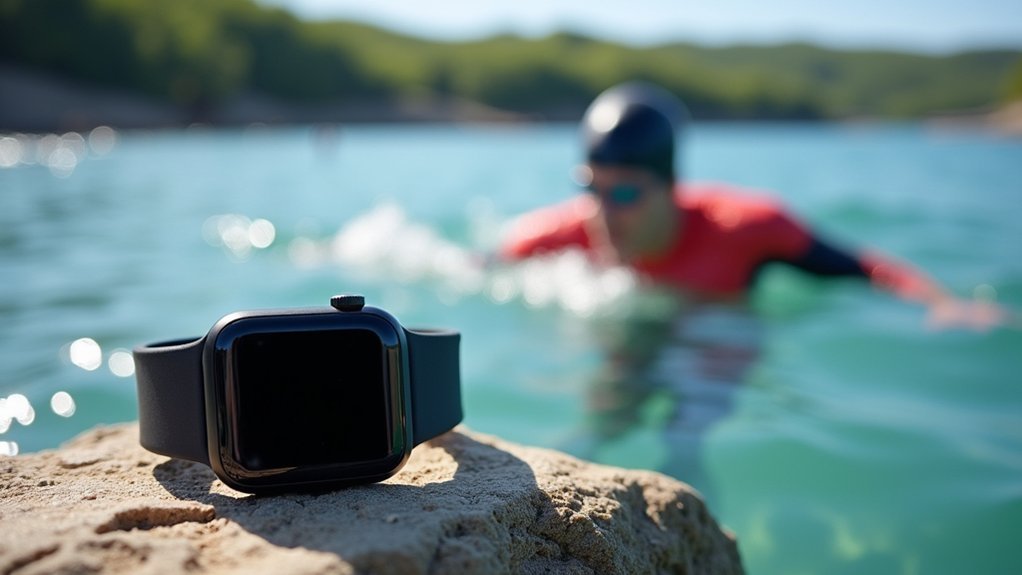



Leave a Reply